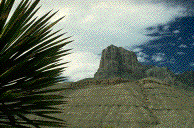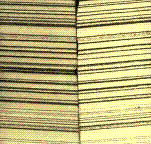


Layers of Time
As the drums of radioactive trash travel down the waste handling shaft at WIPP they passes through dirty red-brown mudstone and sandstone, pass a leaking seal in the shaft, descend past hard, brownish dolomite, and stop at a human cavern carved into impure rock salt sandwiched between layers of white anhydrite. Layers of salt and anhydrite in the walls of the waste chamber, thicker than books on a shelf, tell of heat and evaporation in a shallow sea that once spread across much of kansas, Texas, Oklahoma, and New Mexico. The first plan for WIPP called for a deeper shaft and disposal rooms cut into the pure rock salt of the Castile Formation.
This is where we are heading, to the Castile Formation.
WIPP and all we have considered up to now is prologue. What I really want
to tell you about is something rare and fascinating in the geologic formation
beneath the disposal rooms at WIPP chambers and above the pool of confined
salt water. This deeper story offers hope to those who look for less stressful
reasons for being the Earth's guardian. To tell this part of the story,
I must describe the Delaware Basin and its terrain as it was 220 million
years ago.
If you drive about 30 miles south from Carlsbad Caverns along U. S. 180,
toward El Paso, Texas, and look westard, you will see El Capitan,
a towering mountain. El Capitan is made of the same reef-rock which holds
the Caverns. Capitan reef, in the Permian geologic period, encircled a deep
depression which we now call the Delaware Basin. By some tectonic accident
of nature, the crust of the earth in this small part of New Mexico and Texas
lost strength, gave way, and sank into a deep cavity that opened onto a
tropical sea. For many thousands of years a reef grew around the inside
edge of the foundering basin (see the first figure), in much the same way
that reefs make atolls by growing around the outside of volcanic islands.



Left: El Capitan, a rampart of the reef which encircles the Delaware
Basin, exposed today in the Guadalupe Mountains.
Middle: Dark layers of calcium carbonate and light layers of calcium sulfate
of the Castile Formation. The photo is of two different cores, placed side
by side. The core on the left was collected 24 km from the core on the right.
These remarkable annual layers called varves, only millimeters thick, can
be traced across the basin for more than 100 km.
Right: Thick layers of rock salt (halite) separated by thin layers of calcium
sulfate are also annual layers or varves in the Castile Formation and were
formed when salts were concentrated during times of warm and dry climate.
The reef grew to be a bulwark, blocking the sand and the
silt and the clay that would enter the basin from the country that lay beyond,
keeping these fragments of rock from quickly filling the basin. What remained
was a deep body of blue water, loaded with the ocean salts of sulfate and
chloride.
Within the surrounding reef, only thin layers of pure limestone, and gypsum,
and rock salt were precipitated, season upon season, year after year, making
the annual layerings called varves. The deep basin, protected by
the reef, held enough room for the more than 200,000 varves in the Castile
Formation.